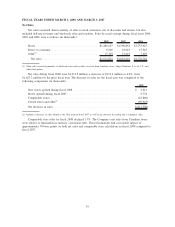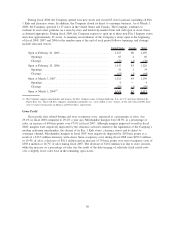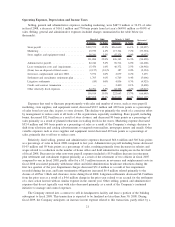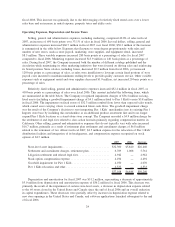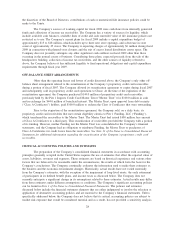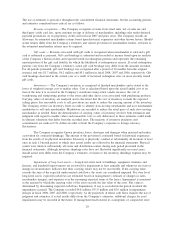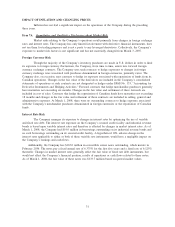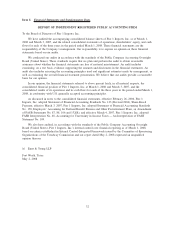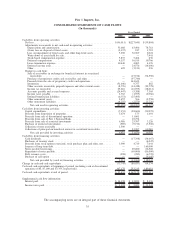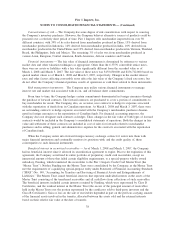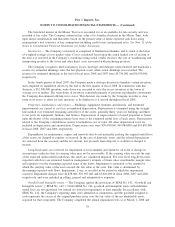Pier 1 2008 Annual Report Download - page 31
Download and view the complete annual report
Please find page 31 of the 2008 Pier 1 annual report below. You can navigate through the pages in the report by either clicking on the pages listed below, or by using the keyword search tool below to find specific information within the annual report.The use of estimates is pervasive throughout the consolidated financial statements, but the accounting policies
and estimates considered most critical are as follows:
Revenue recognition — The Company recognizes revenue from retail sales, net of sales tax and
third-party credit card fees, upon customer receipt or delivery of merchandise, including sales under deferred
payment promotions on its proprietary credit card in fiscal 2007 and prior years. The Company records an
allowance for estimated merchandise returns based upon historical experience and other known factors. Should
actual returns differ from the Company’s estimates and current provision for merchandise returns, revisions to
the estimated merchandise returns may be required.
Gift cards — Revenue associated with gift cards is recognized when merchandise is sold and a gift
card is redeemed as payment. Gift card breakage is estimated and recorded as income based upon an analysis
of the Company’s historical data and expected trends in redemption patterns and represents the remaining
unused portion of the gift card liability for which the likelihood of redemption is remote. If actual redemption
patterns vary from the Company’s estimates, actual gift card breakage may differ from the amounts recorded.
For all periods presented, gift card breakage was recognized after a period of 30 months from the original
issuance and was $1.7 million, $6.2 million and $5.1 million in fiscal 2008, 2007 and 2006, respectively. Gift
card breakage decreased in the current year as a result of increased redemption rates on more recently issued
gift cards.
Inventories — The Company’s inventory is comprised of finished merchandise and is stated at the
lower of weighted average cost or market value. Cost is calculated based upon the actual landed cost of an
item at the time it is received in the Company’s warehouse using actual vendor invoices, the cost of
warehousing and transporting product to the stores and other direct costs associated with purchasing products.
Carrying values of inventory are analyzed and to the extent that the cost of inventory exceeds the expected
selling prices less reasonable costs to sell, provisions are made to reduce the carrying amount of the inventory.
The Company reviews its inventory levels in order to identify slow-moving merchandise and uses merchandise
markdowns to sell such merchandise. Markdowns are recorded to reduce the retail price of such slow-moving
merchandise as needed. Since the determination of carrying values of inventory involves both estimation and
judgment with regard to market values and reasonable costs to sell, differences in these estimates could result
in ultimate valuations that differ from the recorded asset. The majority of inventory purchases and
commitments are made in U.S. dollars in order to limit the Company’s exposure to foreign currency
fluctuations.
The Company recognizes known inventory losses, shortages and damages when incurred and makes
a provision for estimated shrinkage. The amount of the provision is estimated based on historical experience
from the results of its physical inventories. Inventory is physically counted at substantially all locations at least
once in each 12-month period, at which time actual results are reflected in the financial statements. Physical
counts were taken at substantially all stores and distribution centers during each period presented in the
financial statements. Although inventory shrinkage rates have not fluctuated significantly in recent years,
should actual rates differ from the Company’s estimates, revisions to the inventory shrinkage expense may be
required.
Impairment of long-lived assets — Long-lived assets such as buildings, equipment, furniture and
fixtures, and leasehold improvements are reviewed for impairment at least annually and whenever an event or
change in circumstances indicates that their carrying values may not be recoverable. If the carrying value
exceeds the sum of the expected undiscounted cash flows, the assets are considered impaired. For store level
long-lived assets, expected cash flows are estimated based on management’s estimate of changes in sales,
merchandise margins, and expenses over the remaining expected terms of the leases. Impairment is measured
as the amount by which the carrying value of the asset exceeds the fair value of the asset. Fair value is
determined by discounting expected cash flows. Impairment, if any, is recorded in the period in which the
impairment occurred. The Company recorded $4.8 million, $31.9 million and $5.6 million in impairment
charges in fiscal 2008, 2007 and 2006, respectively. As the projection of future cash flows requires the use of
judgment and estimates, if actual results differ from the Company’s estimates, additional charges for asset
impairments may be recorded in the future. If management had lowered its assumptions of comparable store
29


